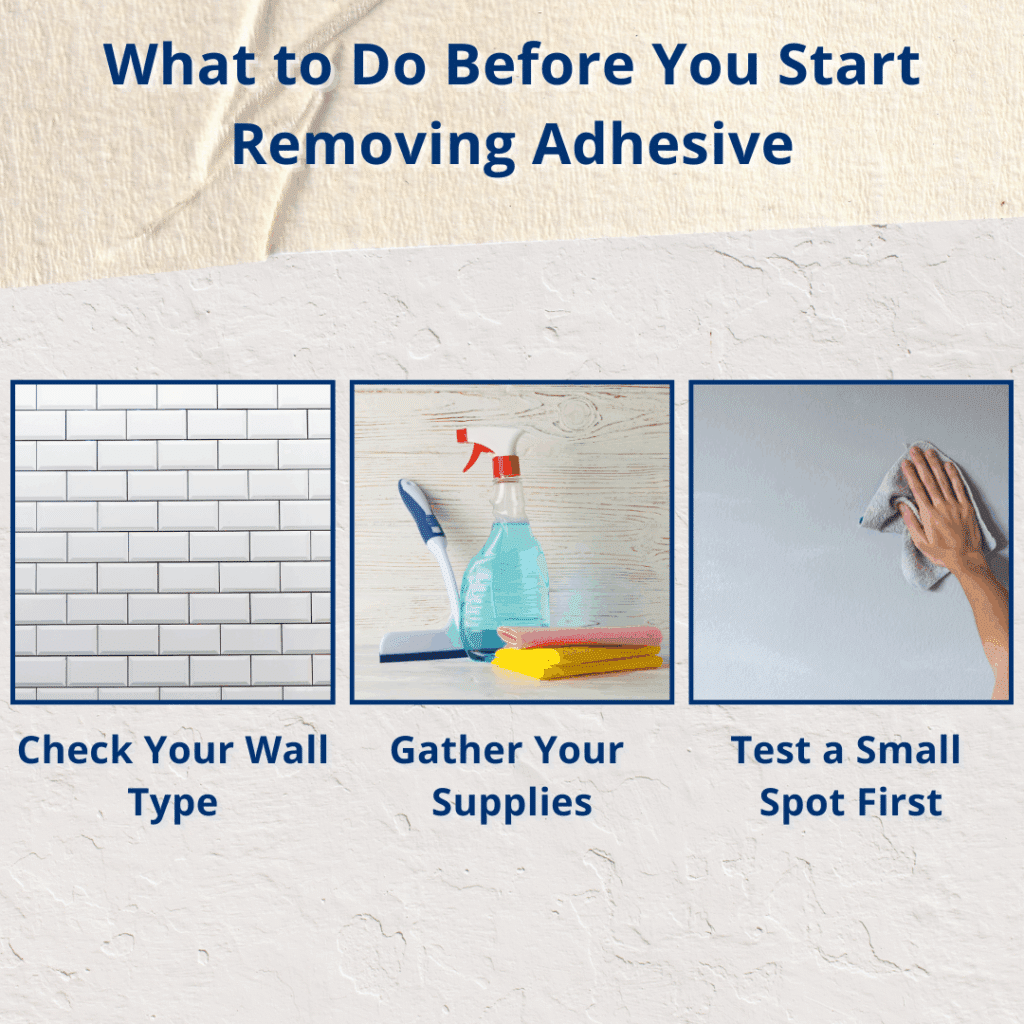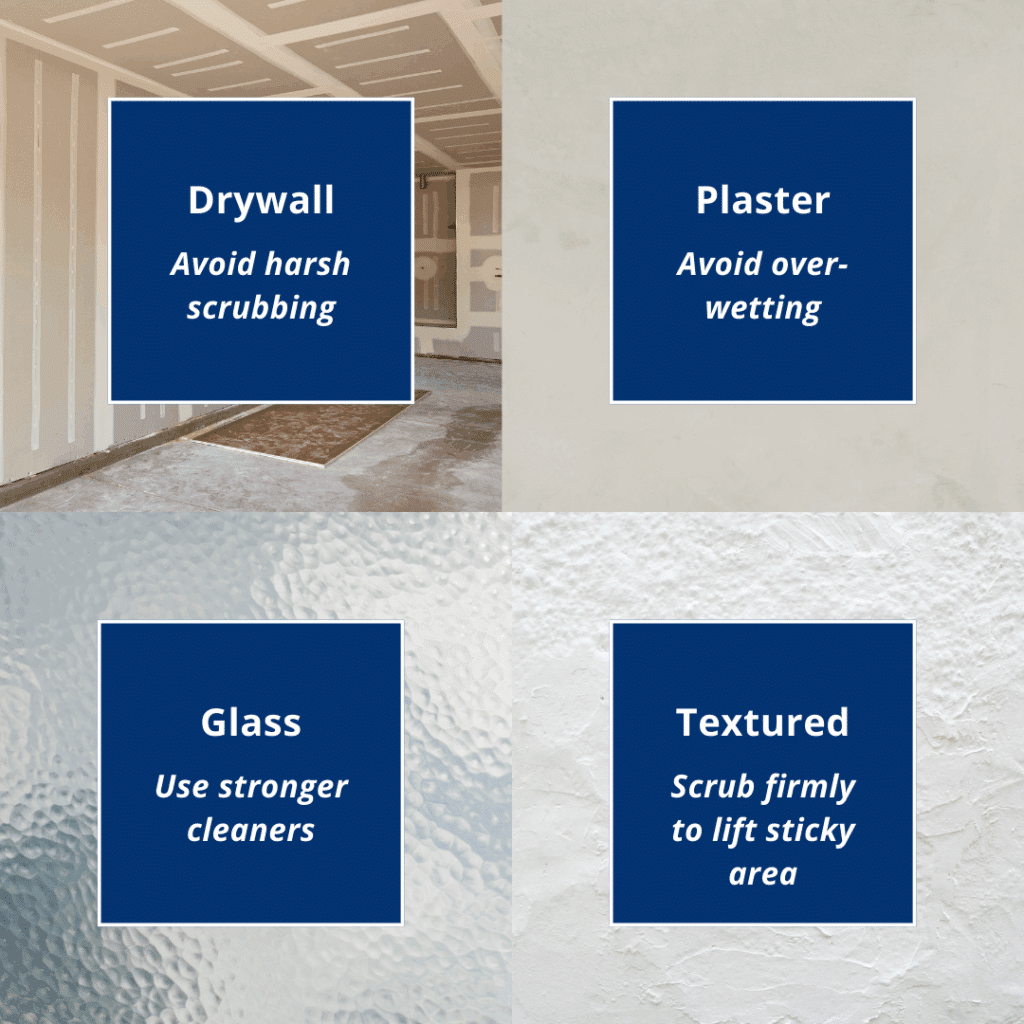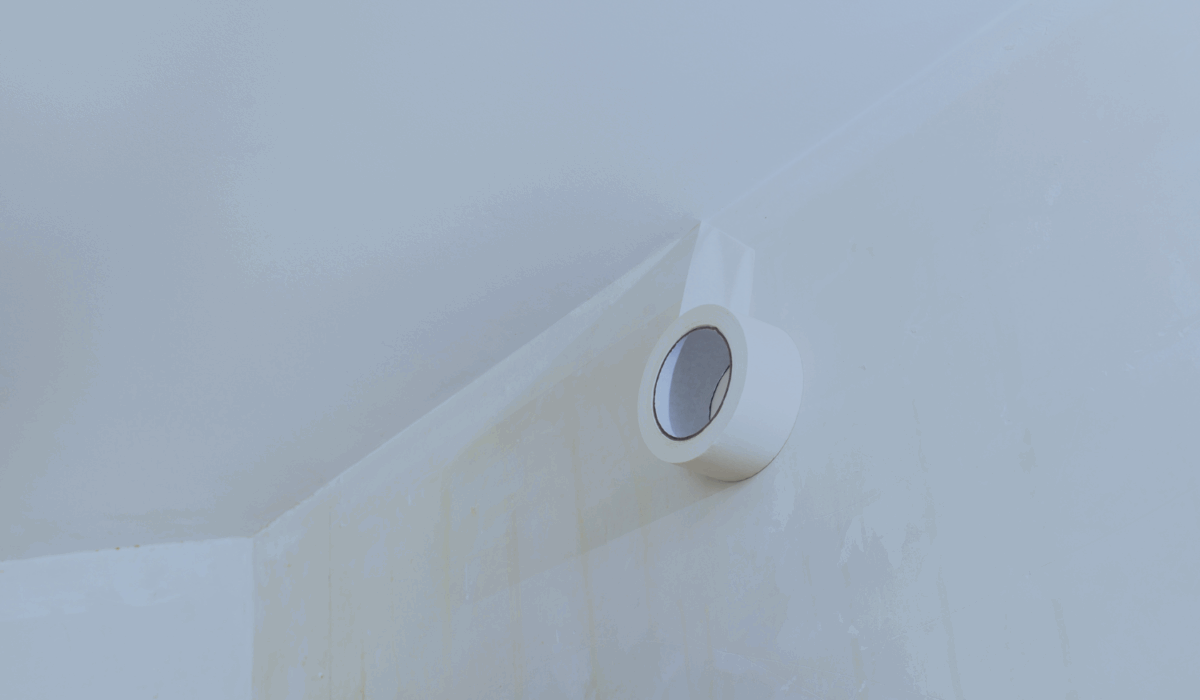If you want to know how to get adhesive off wall surfaces without damaging paint, the key is to start gently and work step by step. Warm soapy water, a hair dryer, or simple household items like vinegar, rubbing alcohol, or natural oils can loosen sticky residue. Once it softens, you can wipe or scrape it away safely.
Most adhesives can be removed with a little patience, and knowing which method works best will keep your walls clean and free of damage.
Why Adhesive on Walls Is a Common Problem
Adhesive doesn’t just appear on walls; it’s put there for convenience. Whether it’s hanging holiday decorations, sticking up posters, or mounting hooks to hold towels, most homeowners rely on some kind of adhesive product. The trouble comes later when it’s time to remove it.
Here are a few common culprits:
- Mounting strips and hooks: These are meant to hold items securely but often leave behind a stubborn layer of sticky residue.
- Painter’s tape or duct tape: Tape may peel off easily at first, but if it stays on too long, the adhesive hardens and bonds with the paint.
- Wall decals and stickers: Popular in kids’ rooms or for décor, stickers tend to leave residue once peeled away.
- Double-sided tape: Strong bonding means strong sticking power and a tougher cleanup.
Since adhesives are designed to stick tightly, it’s no surprise they cling to paint, drywall, or plaster longer than you’d like. If not removed properly, they can pull off paint, leave stains, or even tear drywall paper. That’s why learning how to get adhesive off wall surfaces safely saves you time, money, and frustration.

What to Do Before You Start Removing Adhesive
Before you dive in, it’s important to know what you’re working with.
- Check your wall type. Is it smooth drywall, plaster, tile, or glass? Painted drywall is the most delicate and needs the gentlest touch. Tile and glass can handle stronger cleaners.
- Gather your supplies.
- Microfiber cloths – These are soft and non-abrasive, making them perfect for wiping down walls without scratching paint or finishes. They’re also reusable and highly absorbent.
- Mild dish soap – A few drops mixed with warm water can break down light adhesive residue safely. Harsh cleaners aren’t necessary for most jobs.
- Warm water – Essential for loosening sticky spots and rinsing away cleaning solutions. Always use it in small amounts to avoid saturating walls.
- White vinegar – A natural cleaner that’s gentle yet effective at dissolving sticky residue. It’s safe for most surfaces when used sparingly.
- Rubbing alcohol – Works well for tougher adhesive spots, especially tape residue. It evaporates quickly, so it won’t oversaturate your walls.
- A plastic scraper or old credit card – Helpful for carefully lifting adhesive without gouging the surface. Plastic is safer than metal, which can scratch or chip walls.
- Hair dryer (or heat gun on low) – Heat softens adhesives, making them easier to peel or wipe away. Keep it on a low setting and move it around to avoid overheating one area.
- Test a small spot first. Dab a little cleaner on an out-of-sight corner of the wall. If the paint stays intact, you’re safe to move forward.
Pro tip: If you’re planning to repaint, removing adhesives properly helps the new paint go on evenly. You can check out our guide on preparing walls for painting for extra steps.
Step-by-Step Methods
Start with Gentle Cleaning
Always begin with the least harsh method. Mix a few drops of dish soap into warm water. Dip your cloth, wring it out, and rub the sticky area in circles. Many light residues break down this way. It’s simple, safe, and usually enough for things like tape marks left on the wall for a short time.
Apply Heat to Loosen Sticky Residue
If soap and water don’t work, heat is your best friend. Hold a hair dryer a few inches from the adhesive for 20–30 seconds. The warmth softens the glue so you can peel or wipe it away with ease. This method is especially useful for mounting strips or wall hooks. Be careful not to overheat painted walls — steady, gentle heat works best.
Try Household Solutions for Stubborn Adhesive
Some sticky messes need extra help. Household items are often safer than harsh chemical removers.
- Rubbing alcohol: A small amount on a cloth works wonders on tape residue.
- White vinegar: Breaks down adhesives while being gentle on most walls.
- Natural oils: Olive oil or coconut oil can loosen thick, gummy residue.
After applying, let it sit for a few minutes, then wipe clean with a damp cloth to avoid greasy or vinegar smells.
If the residue still won’t budge, use a scraper, but carefully. A plastic scraper or the edge of an old credit card can lift stubborn adhesive without scratching. Avoid knives or metal tools because they can gouge drywall or leave permanent scratches.
Avoiding Damage to the Paint
Painted walls are tricky because too much moisture or pressure can strip the color. Here are safe tips:
- Work slowly and in layers, not all at once.
- Don’t flood the wall with water or cleaner; light dabbing works best.
- Stick to mild solutions like vinegar or diluted rubbing alcohol.
- If some paint does peel away, patch it with leftover paint.
According to home maintenance experts, repainting even a small area can cost $2-6 per square foot, depending on labor and materials. That’s why careful adhesive removal pays off.
Tips for Different Wall Surfaces
Each surface responds differently to cleaning methods. Here’s a quick guide:
- Drywall: Use the gentlest approach. Avoid soaking or harsh scrubbing, since drywall paper damages easily.
- Plaster: Plaster is harder than drywall but still porous. Use damp cloths sparingly and avoid over-wetting.
- Tile or Glass: These can handle stronger cleaners like vinegar or alcohol. Adhesive tends to come off more easily here.
- Textured walls: Adhesive can get stuck in grooves. Press a microfiber cloth with vinegar or rubbing alcohol firmly into the texture to lift residue.

Prevent Adhesive Mess in the Future
The easiest cleanup is the one you never have to do. Try these prevention tips:
- Use removable hooks designed to peel away cleanly.
- Swap regular tape for painter’s tape, which is built to release easily.
- Clean the wall before applying adhesives so dirt doesn’t create extra sticking power.
- Take down adhesives sooner rather than later. The longer they stay, the harder they stick.
By planning ahead, you’ll avoid the frustration of sticky patches and protect your walls from damage.
Related Questions
What is the best adhesive remover for painted walls?
Rubbing alcohol and vinegar are safe for most painted walls. Commercial adhesive removers may be too harsh unless the wall is tile or glass.
Can vinegar damage painted drywall?
Vinegar is mild and generally safe. Still, always test a hidden spot on the wall before using it across a larger area.
How do you fix wall damage after removing adhesive?
Small chips can be covered with touch-up paint. For larger spots, sand the foundation lightly, patch with spackle, and repaint.
What’s the easiest way to prepare a wall for repainting after adhesive removal?
Make sure the wall is clean, smooth, and dry. A light sanding helps remove any leftover residue before you repaint.
Conclusion
Getting adhesive off wall surfaces doesn’t have to mean damaged paint or expensive repairs. By starting with gentle methods, adding heat, and using safe household cleaners, most adhesives can be removed in minutes. The key is patience and the right approach for your wall type.
Sticky adhesives may be easy to overlook, but they can cause bigger problems if ignored — just like hidden issues in your home. At Edifice Inspections, we help homeowners uncover those problems before they grow costly. If you want to keep your home safe, sound, and looking its best, schedule a professional home inspection today.


2 Comments
Comments are closed.